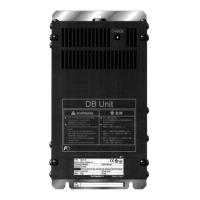6.5 When Codes Other Than Alarm Codes and Light Alarm Indication (
l-al
) are Displayed
6-26
Possible Causes Check and Measures
(16) No enable inputs [EN1], [EN2]
are entered.
Check the EN terminal input state by using “I/O Checking” from the
Menu on the keypad.
Connect the terminals [EN1], [EN2].
See Chapter 2 “2.2.6 [3] Description of terminal functions” [EN1],
[EN2].
[ 2 ] The motor rotates, but the speed does not increase
Possible Causes Check and Measures
(1) The maximum frequency
currently specified was too low.
Check the data of function code F03* (Maximum frequency).
Correct the F03* data.
(2) The data of frequency limiter
(Upper limit) currently specified
was too low.
Check the data of function code F15 (Frequency limiter (Upper limit)).
Correct the F15 data.
(3) Speed setting is not changing
(Analog setting).
Check that the reference frequency has been entered correctly, using
Menu “I/O Checking” on the keypad.
Increase the reference frequency.
Inspect the external frequency command potentiometers, signal
converters, switches, and relay contacts. Replace any ones that are
faulty.
Connect external circuit wirings of terminals [13], [12], [11], [C1]
correctly.
(4) A frequency command (e.g.,
multi-frequency or via
communications) with higher
priority than the one attempted
was active and its reference
frequency was too low.
Based on the frequency setting block diagram (See Chapter 8 “BLOCK
DIAGRAMS FOR CONTROL LOGIC”), check the inputted frequency
command by function code data check and I/O checking from Menu
using the keypad.
Correct any incorrect data of function codes (e.g. cancel the higher
priority frequency command).
(5) The acceleration time was too
long or too short.
Check the data of acceleration times (F07, E10, E12, E14, H54).
Change the acceleration time to match the load.
(6) Overload. Measure the inverter output current.
Reduce the load.
Check whether any mechanical brake is applied.
Release the mechanical brake.
(7) Function code settings do not
agree with the motor
characteristics.
When automatic torque boost and automatic energy-saving operations
are performed, confirm that P02*, P03*, P06*, P07*, P08* agree with
motor constants.
Perform auto-tuning of the inverter for every motor to be used.
(8) The output frequency does not
increase due to the current
limiter operation.
Make sure that F43 (Current limiter (Mode selection)) is set to “2” and
check the data of F44 (Current limiter (Level)).
Change the F44 data correctly. Or, set the F43 data to “0” (Disable)
if the current limiter operation is not needed.
Decrease the value of torque boost (F09*), then run the motor again and
check if the speed increases.
If no stall occurs, decrease the F09* data.
Check the data of function codes (F04*, F05*, H50, H51, H52, H53,
H65, and H66) to ensure that the V/f pattern setting is right.
Match the V/f pattern setting with the motor ratings.

